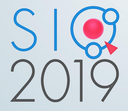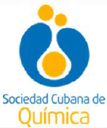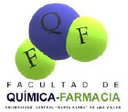Executive Secretary

7th International Chemistry Symposium
SIQ 2019
The physical, mechanical and biological properties of resin composites are strongly influenced by the degree of conversion, defined as the percentage of reacted aliphatic C=C bonds from the dimethacrylate monomers present in their polymeric matrices. The aim of this study was to determinate by FTIR of degree of conversion of nanofilled light-cured dental composites from a new monomeric system. Experimental composite was prepared from 2, 2 bis [4-(2-hidroxy 3-metacriloxypropoxi) phenyl] propane (Bis-GMA) and tetraethyleneglycol dimethacrylate (TEEGDMA), 3-methacryloxypropyl trimethoxysilane (MPS) mixture as monomeric matrices and 25, 35, 45 % of colloidal silica particles (Aerosil OX 50) as filler. The initiation system was based on the pair Camphorquinone (CQ) / N,N dimethylaminoethyl methacrylate (DMAEMA). The morphology and size of aerosil OX50 was observed by scanning electron microscopy. The experimental composites and a commercial dental composite used as reference (Solar Light Cure Composite) were submitted to determinations of degree of conversion (DC) by FTIR to 0, 1, 2, 3, 4, 5, 10, 15, 20, 25, 30, 35, 40 and 80s to irradiate using an LED lamp (430-490nm, 850-1000mW/cm). The micrographs of the OX50 aerosil show semisphericals particles and it is aglomerates with a size between 50-100 nm. Experimental composite presented values for conversion between 70-80%. The commercial dental composite showed values around 77%. According to the results obtained, the composite with 35% of nanofiller shows the best degree of conversion.
The physical, mechanical and biological properties of resin composites are strongly influenced by the degree of conversion, defined as the percentage of reacted aliphatic C=C bonds from the dimethacrylate monomers present in their polymeric matrices. The aim of this study was to determinate by FTIR of degree of conversion of nanofilled light-cured dental composites from a new monomeric system. Experimental composite was prepared from 2, 2 bis [4-(2-hidroxy 3-metacriloxypropoxi) phenyl] propane (Bis-GMA) and tetraethyleneglycol dimethacrylate (TEEGDMA), 3-methacryloxypropyl trimethoxysilane (MPS) mixture as monomeric matrices and 25, 35, 45 % of colloidal silica particles (Aerosil OX 50) as filler. The initiation system was based on the pair Camphorquinone (CQ) / N,N dimethylaminoethyl methacrylate (DMAEMA). The morphology and size of aerosil OX50 was observed by scanning electron microscopy. The experimental composites and a commercial dental composite used as reference (Solar Light Cure Composite) were submitted to determinations of degree of conversion (DC) by FTIR to 0, 1, 2, 3, 4, 5, 10, 15, 20, 25, 30, 35, 40 and 80s to irradiate using an LED lamp (430-490nm, 850-1000mW/cm). The micrographs of the OX50 aerosil show semisphericals particles and it is aglomerates with a size between 50-100 nm. Experimental composite presented values for conversion between 70-80%. The commercial dental composite showed values around 77%. According to the results obtained, the composite with 35% of nanofiller shows the best degree of conversion.
About The Speaker

Dr. Yaymarilis Veranes Pantoja






